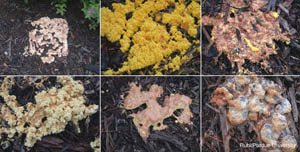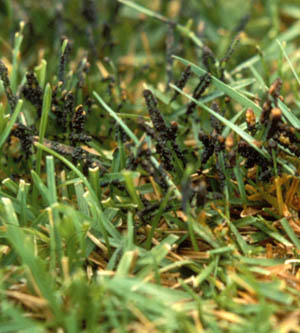Slime Molds in the Landscape | |
|---|---|
| July 11, 2007 | |
|
Mulched areas under shrubs and at the base of trees provide the perfect habitat for harmless, but nevertheless alarming, slime molds. These organisms were once believed to be fungi but are now understood to be amoeba-like protists, similar to fungi. Slime molds feed on decomposing organic matter, and can be found in almost any given spot in the home landscape: sidewalks, mulched areas, wood chips in play areas, or over vegetation such as turfgrass, strawberries, flowers, ground covers, weeds, and the base of woody plants. Because they are not parasitic, they do not cause direct harm to your plants or your family. Occasionally, they can cause problems on lawns or low-growing ground covers by blocking the sunlight that plants need to grow. Slime molds range in color and size, often seeming to appear suddenly after a period of warm, wet weather. They are also commonly found during the summer in irrigated landscapes. The plasmodium, or “feeding” stage, appears as a slimy, amoeba-like organism. Slime molds may be watery-white, gray, cream to light yellow, bright yellow to orange, violet, blue, green, or purple–brown greasy masses and can get as large as one to two feet in diameter. The image by Gail Ruhl at Purdue University shows many colors of slime molds.  One type of slime mold displays an unpopular resemblance to dog vomit. The plasmodium soon develops colorful, crusty fruiting bodies filled with masses of dusty spores. These organisms do “move,” albeit too slowly to watch. Homeowners are often concerned when, after a day to several days, they notice that the colorful and slimy “blobs” have migrated a short distance. One type of slime mold displays an unpopular resemblance to dog vomit. The plasmodium soon develops colorful, crusty fruiting bodies filled with masses of dusty spores. These organisms do “move,” albeit too slowly to watch. Homeowners are often concerned when, after a day to several days, they notice that the colorful and slimy “blobs” have migrated a short distance.No chemical controls are known, or needed, to combat slime molds. They usually dry up and disappear in dry weather. If you have some unsightly patches in a garden that you wish to eliminate, remove the spore masses in a plastic bag and break up the remaining masses by vigorous raking or brushing. Although some like to hose down the spores with a water stream, keep in mind that water can also spread the problem by spreading around the swimming spores. Mowing is usually sufficient to remove the spore masses from slime molds on lawns. The image shows slime mold on turfgrass.  For more information about slime molds, read Report on Plant Disease, no. 401, “Slime Molds of Turfgrass.” The publication is available in Illinois Extension offices or at http://www.ag.uiuc.edu/~vista/abstracts/a401.HTML. An excellent site with images of slime molds was created by Tom Volk, a University of Wisconsin mycologist, and can be viewed at http://botit.botany.wisc.edu/toms_fungi/june99.html. (Shanyn Siegel and Nancy Pataky) |